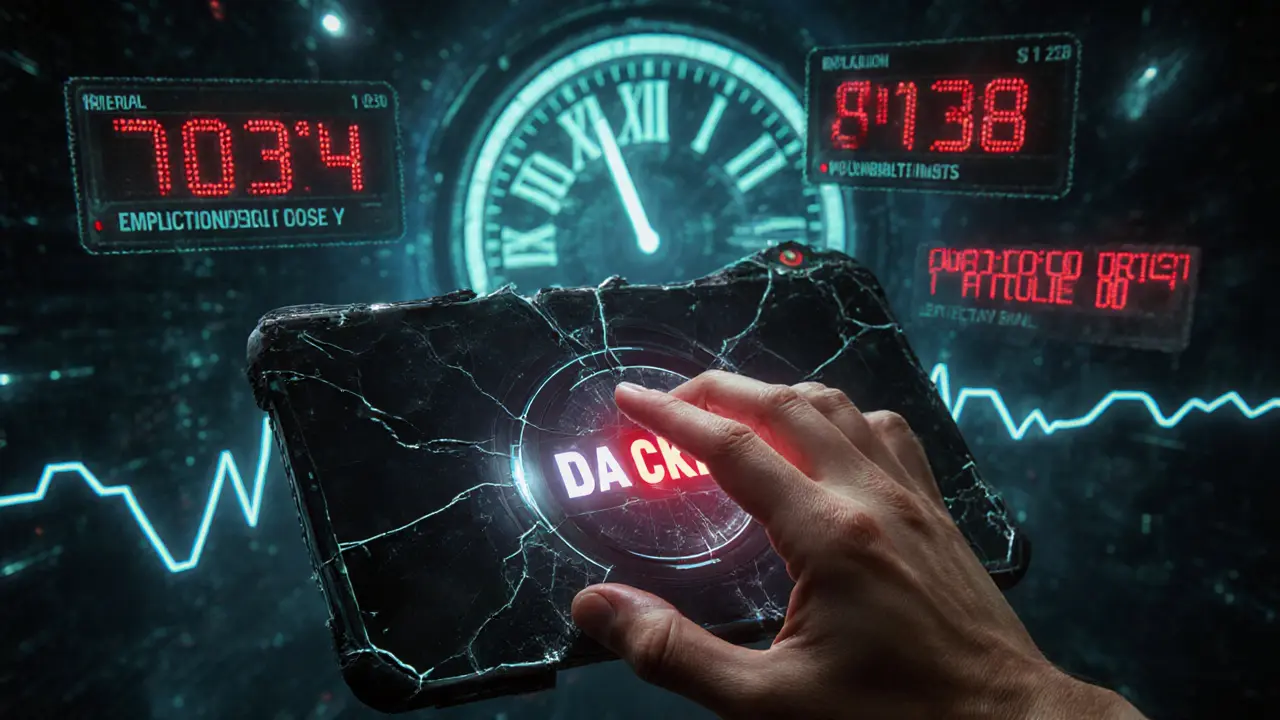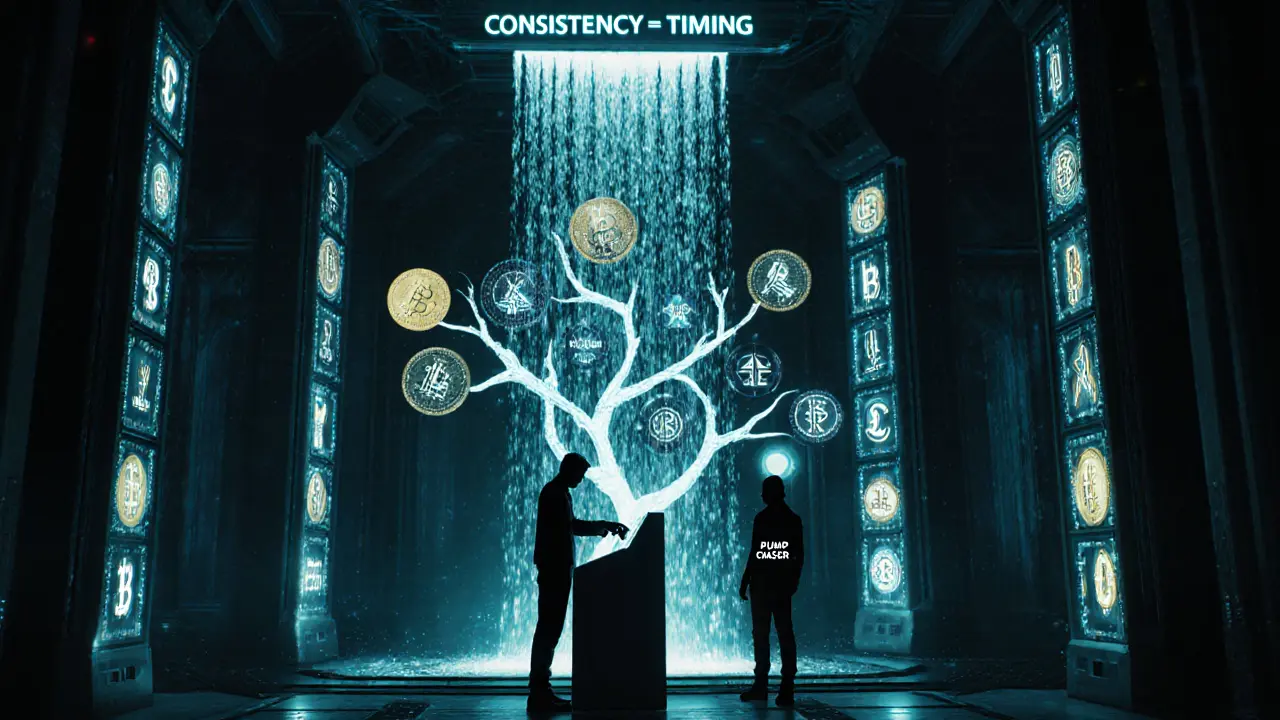Crypto DCA Fee Calculator & Impact Simulator
Based on 52 trades per year
Key Results
Your fees are eating into your investment...
People start dollar cost averaging (DCA) in crypto because they want to avoid the stress of timing the market. It sounds simple: invest $50 every week, no matter if Bitcoin is at $30,000 or $60,000. But in practice, most investors mess it up-sometimes in ways that cost them thousands.
You’re probably buying only one coin
The biggest mistake? Putting all your DCA money into Bitcoin or Ethereum alone. DCA is meant to smooth out risk, but if you only buy one asset, you’re still betting everything on a single gamble. What if Ethereum’s development slows? What if Bitcoin gets regulated into a corner? You’re not diversified-you’re just buying the same risky thing on a schedule.Real DCA means spreading your weekly $50 across 3-5 different cryptos with different use cases: one for payments (like Litecoin), one for smart contracts (like Solana), one for privacy (like Monero), one for DeFi (like Aave), and one for Bitcoin. You don’t need to research every token, but you need to understand their basic purpose. Buying only Bitcoin because it’s popular is like buying only Ford trucks because they’re everywhere-you might miss the Tesla that outperforms it.
You’re investing more than you can afford to lose
CoinShares says crypto should make up 4% to 7.5% of your total investment portfolio. That’s not a suggestion-it’s a safety rule. If you’re putting 20% of your savings into crypto because you saw someone make 10x on XRP, you’re already playing with fire.Ask yourself: if your entire crypto portfolio dropped to zero tomorrow, would you miss rent? Would you have to sell your car? If yes, you’ve gone too far. Crypto moves fast. A coin can drop 30% in a week. If you’re emotionally tied to every dollar you put in, you’ll panic-sell when the market dips, even if you’re doing DCA. DCA only works if you can sleep at night.
You’re ignoring fees
You think $1.99 per trade doesn’t matter. But if you’re buying $50 every week, that’s 52 trades a year. $1.99 x 52 = $103.48 in fees. That’s over 20% of your annual investment gone just to the exchange. Over five years, that’s more than $500 lost to fees alone.Platforms like Coinbase and Binance charge different fees. Some charge flat fees, others a percentage. Some offer free recurring buys on certain coins. You need to pick a platform that supports automated DCA with low fees. Look for exchanges that offer $0 trading fees on recurring purchases for Bitcoin or Ethereum. If your platform doesn’t let you automate or charges too much, switch. Fees are silent killers.
You’re chasing the pump
The market goes up. You see your portfolio grow. Suddenly, you think: “Why only $50? I should put in $200 this week.” That’s not DCA. That’s gambling.DCA’s power comes from buying when prices are low. When the market surges, you’re buying at the top. That’s the opposite of what you want. If you feel tempted to increase your investment during a rally, pause. Write down your plan: “I invest $50 every Tuesday, no exceptions.” Stick to it. Emotional decisions destroy DCA. CoinShares found that 73% of retail investors who abandoned their DCA schedule during bull markets ended up with lower returns than those who stayed consistent.

You’re not adjusting during long downturns
DCA isn’t a robot. It’s a tool. If the market crashes and stays down for 18 months, you might need to adjust. That doesn’t mean stopping. It means rebalancing.Let’s say you’re buying Bitcoin, Ethereum, and Cardano. After a year, Bitcoin is up 40%, Ethereum flat, Cardano down 60%. Your portfolio is now 60% Bitcoin, 25% Ethereum, 15% Cardano. That’s not your original allocation. You’ve drifted. You need to rebalance: take some profit from Bitcoin and buy more Cardano. That’s not timing the market-it’s maintaining discipline.
Set a rule: “If any single coin makes up more than 50% of my portfolio, I’ll sell a portion and buy others.” This keeps your DCA strategy balanced and reduces concentration risk. Don’t just buy blindly. Monitor and adjust.
You’re not setting an exit plan
Most people start DCA but never think about stopping. What happens when you hit your goal? What if crypto crashes 80% and you’re still buying? You need rules.Decide in advance: “I’ll stop DCA when I’ve invested $10,000 total,” or “I’ll cash out 20% of my holdings if any coin doubles in value.” You can also set a time limit: “I’ll DCA for 5 years, then shift to income.” Without an exit, you risk holding through a bear market that lasts longer than your patience.
UCLA’s research shows that investors who didn’t plan exits held through multi-year crashes and missed better opportunities elsewhere. DCA is for entry-not forever holding.
You’re manually buying instead of automating
If you’re logging into your exchange every Tuesday to buy crypto, you’re already failing. Life gets busy. You’ll miss a week. Or you’ll forget and buy $100 instead of $50. That breaks the rhythm.Use automation. Most major exchanges-Kraken, Gemini, Coinbase, Binance-offer recurring buy features. Set it once: $50 every Tuesday at 8 AM. Done. No thinking. No temptation. No missed days. Automation is what makes DCA work. Manual DCA is just inconsistent investing with a fancy name.

You’re waiting for the “perfect time” to start
“I’ll start when Bitcoin hits $40,000.” “I’ll wait until after the halving.” “I want to see more data.”That’s analysis paralysis. BitPay’s research found that people who waited for the “right moment” lost an average of 14 months of compounding growth. DCA works because you don’t predict. You show up. Every week. Rain or shine. Starting late is the same as never starting.
Don’t wait. Start now. Even if you buy $10 a week. Even if you think the market is high. DCA’s magic is in consistency, not timing.
You’re not researching the coins at all
Buying Shiba Inu because your friend posted a meme isn’t DCA. It’s speculation with a schedule.DCA isn’t a magic wand. It only works if you’re buying assets with real utility. Learn the basics: What problem does this coin solve? Who’s building it? Is the team active? Are there real users? Don’t need to be an expert. Just avoid coins with no whitepaper, no code updates, and no community.
Stick to coins with 2+ years of history, active GitHub commits, and clear use cases. Avoid coins that only exist on TikTok.
Your DCA plan has no risk guardrails
You don’t need stop-losses on every coin. But you do need a rule for when to pause.Example: “If the entire crypto market drops 40% in 30 days, I’ll pause DCA for one month and review.” Why? Because sometimes the market isn’t just volatile-it’s broken. Regulatory crackdowns, exchange collapses, or protocol failures can make entire sectors unsafe. DCA isn’t about blind faith. It’s about disciplined persistence with awareness.
Having a pause rule doesn’t mean you’re quitting. It means you’re thinking. That’s what separates smart investors from those who lose everything.
DCA in crypto isn’t about getting rich fast. It’s about building slowly, safely, and without emotion. Most people fail not because the strategy doesn’t work-but because they treat it like a lottery ticket instead of a financial tool.
Fix your mistakes. Automate. Diversify. Limit your exposure. Ignore the noise. Stick to your plan. That’s how you win.
Is DCA still good if crypto prices are high?
Yes. DCA works best when prices are volatile, not when they’re low. Buying $50 every week means you buy fewer coins when prices are high and more when they’re low. Over time, your average cost drops. Even if Bitcoin is at $70,000, consistent buying still lowers your overall cost basis compared to lump-sum buying at the peak.
How often should I DCA-weekly or monthly?
Weekly is better for most people. More frequent buys smooth out price swings more effectively. Monthly works too, but you’re more exposed to short-term spikes. Weekly buys also make it easier to stick to the habit. The key isn’t frequency-it’s consistency. Pick what fits your cash flow and stick with it.
Should I DCA into Bitcoin only?
No. Bitcoin is the safest bet, but putting all your money into one coin defeats the purpose of DCA as a risk-reduction strategy. Spread your weekly investment across 3-5 coins with different purposes-like Ethereum for smart contracts, Solana for speed, and Monero for privacy. This reduces your exposure if one coin fails.
Can I DCA with fiat currency or only crypto?
You should DCA with fiat-like CAD, USD, or EUR. Buying crypto with crypto (like trading ETH for SOL) isn’t DCA. That’s portfolio rebalancing. DCA means using steady, real-world money to buy crypto regularly. That’s how you avoid emotional trading and build a true long-term position.
How long should I keep DCAing?
There’s no fixed end date, but you should have a goal. Many investors DCA for 5-10 years, then shift to taking profits or using crypto for income. Others keep going indefinitely. The key is to decide in advance: “I’ll DCA until I’ve invested $15,000,” or “I’ll stop when I’m 50.” Without a plan, you risk holding too long and missing better opportunities.
What if I miss a DCA purchase?
Don’t panic. Missing one week doesn’t ruin your strategy. Just resume next week. If you miss multiple weeks, ask why. Was it because you lost money? Then you might be overinvesting. Was it because you forgot? Then automate. The goal isn’t perfection-it’s consistency over time.





Comments
8 Comments
Shanell Nelly
Just started DCA last month with $20/week across BTC, ETH, SOL, and AVAX. My portfolio’s still tiny but I’m sleeping so much better now. No more late-night panic scrolls. Seriously, automation is a game-changer - set it and forget it. 🙌
Aayansh Singh
You people are delusional. DCA only works if you’re buying blue chips. Anything else is gambling with a spreadsheet. Solana? Cardano? Monero? These are vaporware projects with zero real adoption. Stick to Bitcoin or get out. Your ‘diversification’ is just portfolio dilution wrapped in crypto bro jargon.
Rebecca Amy
lol i just buy btc every friday and forget about it. why complicate things? 😅
Darren Jones
One thing I wish more people understood: fees are the silent killer of long-term gains. I used to use Coinbase - $1.99 per trade? That’s $100+ a year gone. Switched to Kraken’s recurring buy feature with $0 fees on BTC and ETH - saved over $500 in 2 years. It’s not sexy, but it’s math. Do the math.
Kathleen Bauer
im so lazy i just set up auto buy on binance and never think about it again. even if the market crashes 80%? still buy. why? bc i dont wanna stress. also i dont know what solana is lol. 🤷♀️
Carol Rice
STOP waiting for the ‘perfect’ price! You’re not a day trader - you’re a wealth builder! I started with $10/week in 2021. Today? My portfolio’s 12x that. Not because I’m smart - because I showed up. Rain or shine. Bull or bear. DCA isn’t magic - it’s discipline. And discipline is sexy. 💪🔥
Laura Lauwereins
So… you’re telling me I’m supposed to care about ‘use cases’ now? I thought crypto was supposed to be the wild west. Now we’re doing portfolio rebalancing like we’re managing a 401(k)? 😴
Gaurang Kulkarni
Most people who DCA don’t even know what blockchain is they just see moon emojis and think they’re Warren Buffett. You think buying 5 coins makes you diversified but you’re just buying five different scams with different logos. Bitcoin is the only real asset. Everything else is a meme with a whitepaper. You’re not investing you’re playing
Write a comment